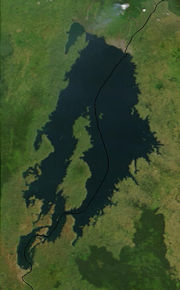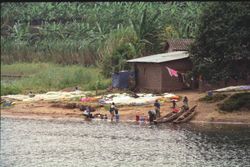Lake Kivu
2007 Schools Wikipedia Selection. Related subjects: African Geography
| Lake Kivu | |
|---|---|
|
|
|
| Coordinates | , |
| Lake type | Rift Valley lakes, Meromictic |
| Primary outflows | Ruzizi River |
| Catchment area | 7,000 km² |
| Basin countries | Rwanda, Democratic Republic of Congo |
| Max-length | 89 km |
| Max-width | 48 km |
| Surface area | 2,700 km² |
| Average depth | 240m |
| Max-depth | 480m |
| Water volume | 500 km³ |
| Shore length1 | |
| Surface elevation | 1460 m |
| Islands | Idjwi |
| Settlements | Goma, Congo Bukavu, Congo Kibuye, Rwanda Cyangugu, Rwanda |
| 1 Shore length is an imprecise measure which may not be standardized for this article. | |
Lake Kivu is one of the Great Lakes of Africa. It lies on the border between the Democratic Republic of the Congo and Rwanda, and is in the Albertine (western) Rift, a part of the Great Rift Valley. Lake Kivu empties into the Ruzizi River, which flows southwards into Lake Tanganyika. It gained notoriety as a place where many of the victims of the 1994 Rwandan genocide were dumped.
Geography
The lake covers a total surface area of some 2700 km² and stands at a height of 1460 metres above sea level. The lake bed sits upon a rift valley that is slowly being pulled apart, causing volcanic activity in the area. The lake is surrounded by majestic mountains making it a magnificent sight.
A large island, Idjwi, lies in the lake, while settlements on its shore include Bukavu, Kabare, Kalehe, Saké and Goma in Congo and Gisenyi, Kibuye and Cyangugu in Rwanda.
The first European to visit the lake was German Count Adolf von Götzen in 1894. Since then it has been caught between the violent border conflicts.
Chemistry
Lake Kivu is one of three known exploding lakes, along with Cameroonian Lake Nyos and Lake Monoun, that experience violent lake overturns. Analysis of Lake Kivu's geological history indicates a periodic massive biological extinction about every 1,000 years. The trigger for lake overturns in Lake Kivu's case is unknown but periodic volcanic activity is suspected. The gaseous chemical composition of exploding lakes is unique to each lake; in Lake Kivu's case, methane and carbon dioxide due to lake water interaction with a volcano. The risk from a possible Lake Kivu overturn would be catastrophic, dwarfing other documented lake overturns at Lake Nyos, since approximately 2 million people live in the lake basin.
Scientists hypothesize that sufficient volcanic interaction with the lake's bottom water that has high gas concentrations would heat water, force the methane out of the water, spark a methane explosion, and trigger a nearly simultaneous release of carbon dioxide. The carbon dioxide would then suffocate large numbers of people in the lake basin as the gases roll off the lake surface. It is also possible that the lake could spawn lake tsunamis as gas explodes out of it.
The risk posed by Lake Kivu began to be understood during the analysis of more recent events at Lake Nyos. Lake Kivu's methane was only originally thought to be a cheap natural resource for export and the generation of cheap power. Once the mechanisms that caused lake overturns began to be understood, so did the risk the lake posed to the local population.
An experimental vent pipe was installed at Lake Nyos in 2001 to degas the deep water, but such a solution for the much larger Lake Kivu would be extremely expensive, running into millions of dollars. No plan has been initiated to reduce the risk posed by Lake Kivu.
Methane extraction
Lake Kivu has recently been found to contain approximately 55 billion cubic metres of dissolved methane gas at a depth of 300 metres. The Rwandan government has signed an $80 million deal with an international consortium to extract this gas. Extraction is said to be extremely cost effective and simple because once the gas rich water is pumped up the dissolved gases (primarily carbon dioxide, hydrogen sulphide and methane) begin to bubble out as the water pressure gets lower. This project is expected to increase Rwanda's energy generation capability by as much as 20 times and will enable Rwanda to sell electricity to neighbouring African countries.


